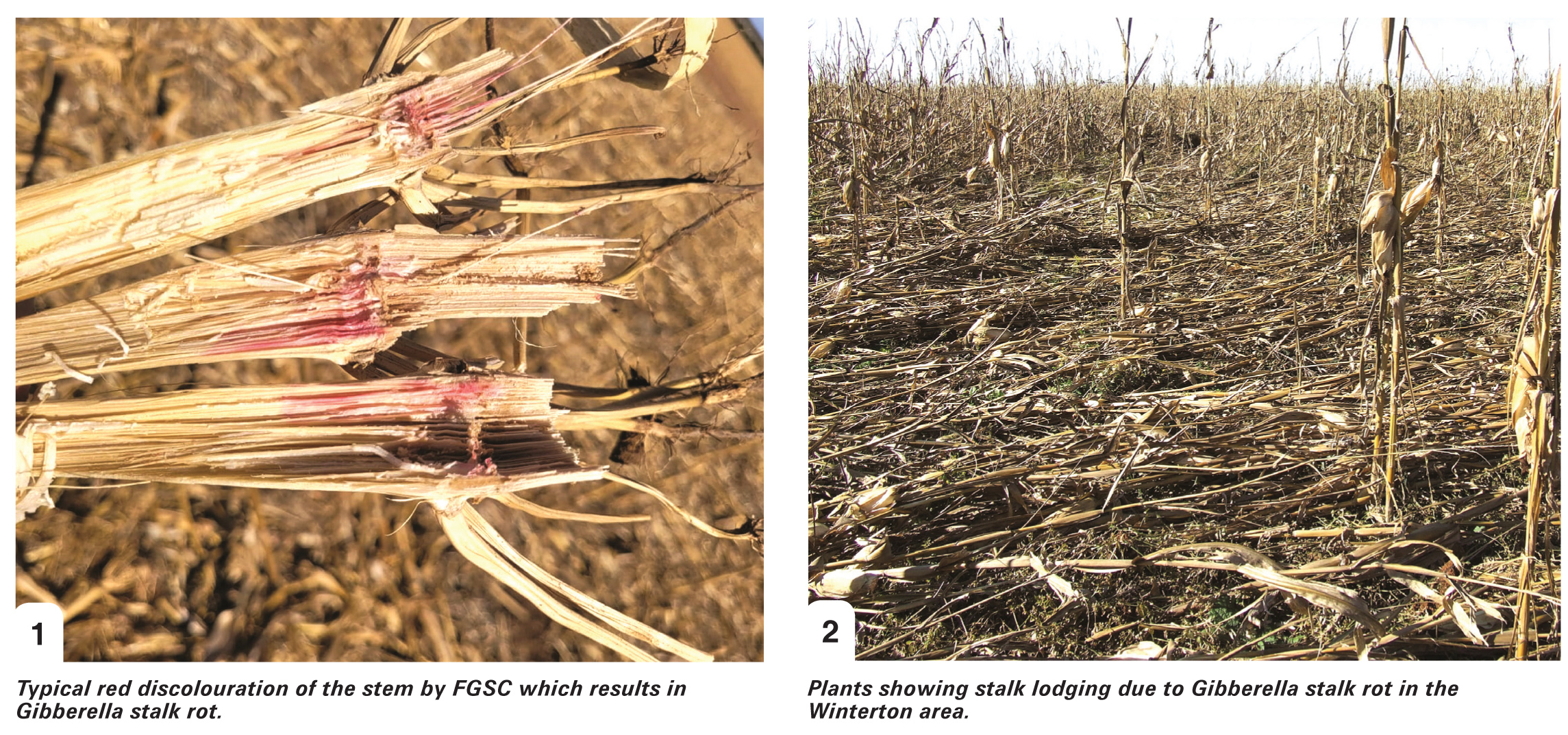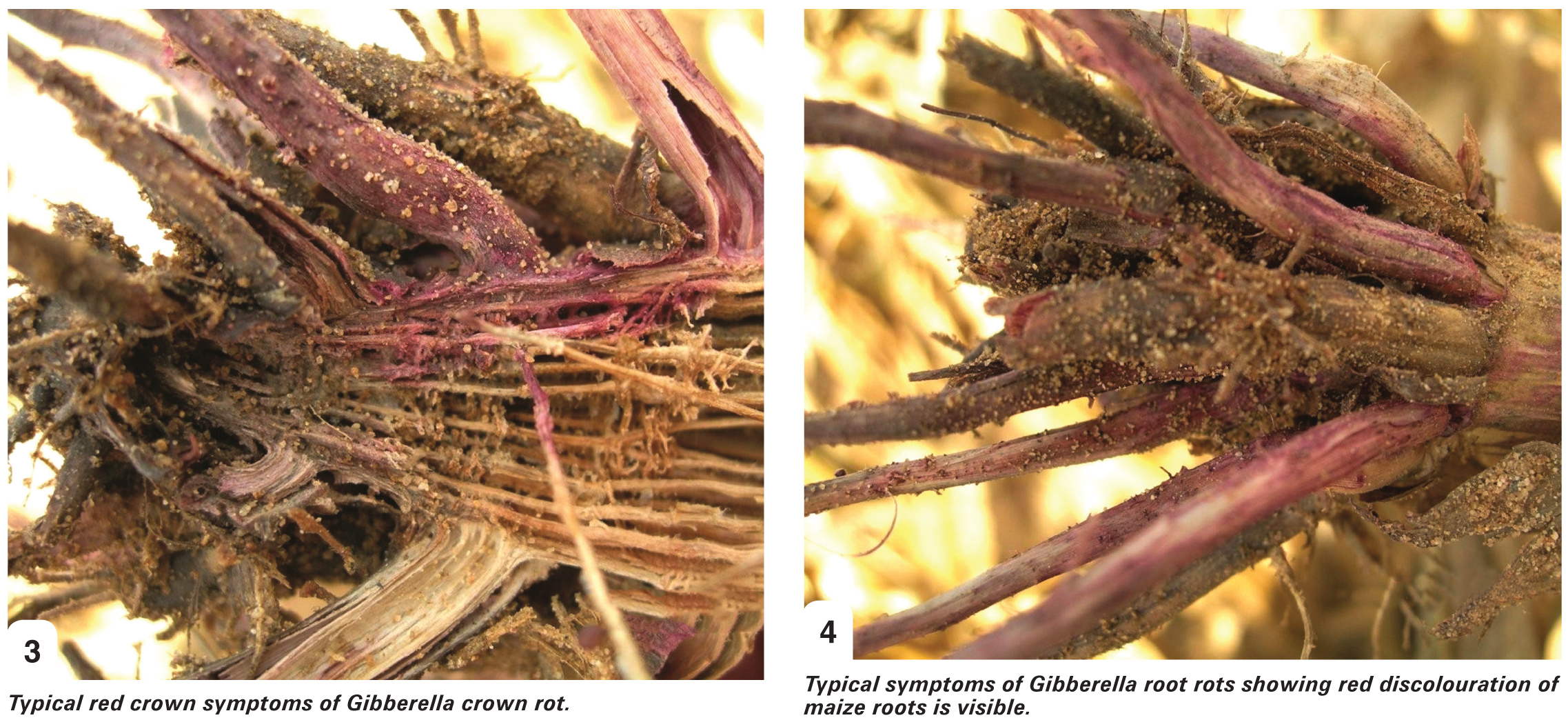March 2024
|
DR BRADLEY FLETT AND DR BELINDA JANSE VAN RENSBURG, BOTH FROM THE ARC-GRAIN CROPS, POTCHEFSTROOM. FIRST PUBLISHED IN SA GRAAN/GRAIN, SEPTEMBER 2023. |
 |
Stalk rot results in yield losses due to impaired grain filling, premature senescence and lodging (limits production and harvesting of ears). In addition, mycotoxins produced by these fungi can render infected stalk tissues unfit for animal consumption. It is a common problem in maize production areas worldwide.
Gibberella stalk rot is caused by fungus pathogens within the Fusarium graminearum species complex (FGSC). The primary crop hosts of FGSC include maize, oat, barley, rye, sorghum and wheat.
ECONOMIC IMPORTANCE
Although it is difficult to estimate precise yield loss, FGSC stalk rot can cause extensive economic losses. This is due to premature plant death, interference with translocation of water and nutrients because of fungal growth on xylem and phloem tissues in the stalk during grain fill (poor grain fill) as well as lodging of plants due to weakened stems during favourable environmental conditions.
Kernels on affected ears are smaller than healthy plant grain and are often loose on the ear (can be quantified by using thousand kernel weight as a parameter). Lodging of infected plants complicates mechanical operations. Plants then need to be picked up and harvested by hand, which in turn increases harvest time, labour and input costs.
SYMPTOMS


Stalk infections may occur during the vegetative growth stage, but the symptoms thereof generally manifest shortly after pollination and at onset of grain fill and develop at the origin of the leaf sheaths or around the brace roots. The fungus may also infect the plant through its roots and then grow up into the lower stem.
CONTROL
Crop rotation
A maize-based crop rotation system with legumes or sunflower will allow maize stubble to break down and not provide a suitable host for the fungus to survive on, thereby reducing the inoculum. However, recently published work indicates that the possible host range on which the FGSC may infect or survive is far wider than originally thought.
Resistance
Hybrids with resistance to other stalk rots (such as Diplodia) may also show resistance to Gibberella stalk rot. However, this resistance may rather be due to breeders that focused on plant stalk strength and standability and not directly to the disease. In fact, the stronger stalks may increase the survival of stalk rot pathogens because these stalks break down slower and the natural decay process is delayed.
Although a lot of effort has been made to select hybrids with stalk rot resistance, the main consideration is still high yield production. Genotypes that produce higher yields tend to have bigger ears, which act as larger sinks and a greater demand for carbohydrates in the plants. The higher demand because of the larger ears results in reduced carbohydrate levels in the lower stem, which predispose the plant to stalk rot. The balance between breeding for resistance to stalk rot and breeding for high yield is, therefore, delicate.
Nutrients and stress reduction
Common stress conditions include high nitrogen and low potassium fertility and a high soil moisture or water logging in the mid to late season following a dry, early season experienced during grain fill. A high incidence of leaf diseases causes a reduction of the photosynthetic area of the plant, adding further stress and predisposition to stalk rot. Physical damage creating wounds (insects or hail) that allow the pathogen to enter the maize plant may also predispose the plant to stalk rot.
Cultural practices that reduce plant stress also reduce incidence of stalk rot. Regenerative agriculture (conservation tillage) practices that reserve soil moisture and improve soil nutrient levels may reduce plant stress but may, on the other hand, increase inoculum levels. This play-off between soil and moisture conservation and increased disease levels needs to be breached with innovative research efforts.
Chemical control
There are no fungicides that are directly registered for the control of Gibberella stalk rot. However, fungicide applications for the control of leaf diseases may reduce stress on the plant, thus lessening stalk rot severity and ultimately lodging.
Biological control
There are several biological products presently marketed in South Africa that are alleged to reduce Gibberella stalk rots, generating interest by agronomists and producers. However, the efficacy of these products needs to be confirmed in independent studies by impartial institutions to confirm or refute the claims of efficacy.
Biological agents should therefore be tested under field conditions with accurate disease quantification techniques such as qPCR to quantify the amount of the target fungus within the stalk.
Even though many biological products show antagonistic properties against certain fungal pathogens in the laboratory, it needs to be confirmed in an environment where soil factors vary and may contain a wide range of soil microbes that may influence this efficacy. It is recommended that producers request field data that confirm efficacy before using these products.
CONCLUSION
In conclusion, stalk rots still require a lot of research aimed at developing integrated disease management systems. Research is also required on Fusarium spp. of the FGSC involved in Gibberella stalk rots as well as the epidemiology of these species before integrated systems that are based on accurate scientific data can be developed.
Click on the link to read the complete article: https://sagrainmag.co.za/2023/09/01/gibberella-stalk-rot-of-maize-a-serious-threat/
Publication: March 2024
Section: Pula/Imvula